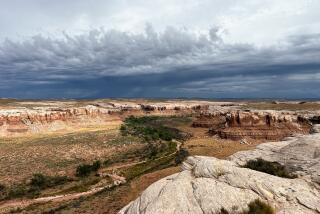Mt. Rushmore’s hidden faces
- Share via
Here are 10 things you probably didn’t know about Mt. Rushmore, one of America’s favorite landmarks.
1. Charles E. Rushmore was a lawyer from New York. He was sent to South Dakota to check titles on some properties around the Black Hills in 1884 or 1885. By the National Park Service’s account, Rushmore asked the name of the mountain, and nearby resident Bill Challis told him it had none -- “but from now on, we’ll call it Rushmore.”
2. Thomas Jefferson is a do-over. At first, sculptor Gutzon Borglum put Thomas Jefferson on George Washington’s right. But after 18 months of carving, Borglum changed plans, dynamited Jefferson off the mountain and put him on Washington’s left. Also, Theodore Roosevelt, the most controversial choice among the four Rushmore presidents, died only eight years before the blasting began.
3. George Washington’s nose is longer than the others by about a foot. His measures 21 feet, top to bottom. The others measure about 20.
4. It’s free. Sort of. Though admission to Mt. Rushmore National Memorial is free, it costs $10 to park in the lot. The Rushmore memorial’s annual tourist tally increased from 2.6 million to 2.9 million in the year after the 2001 terrorist attacks on the U.S. But since then, annual visitation has dropped -- to 2.4 million in 2008, its lowest level this decade.
5. The sculptor had Klan connections. Borglum, who was 60 when he started work on the mountain in 1927, had spent the previous years among the Ku Klux Klan leaders of Georgia. Borglum had devoted years to a Confederate commemorative carving at Stone Mountain, which was financed in part by the Klan. After his death in 1941 (the same year Mt. Rushmore was completed), he was buried at Forest Lawn Memorial Park Cemetery in Glendale.
6. Fourth of July fireworks? Not exactly. Every year in early July, the National Park Service does set off a big fireworks display above the presidents’ heads. But for several years now, the fireworks have been staged on July 3. This scheduling is intended to prevent the show from competing with Independence Day celebrations in Rapid City and other neighboring communities.
7. The chiseling was the least of the work. About 90% of the carving at the mountain was done by dynamite. Those blasts removed about 450,000 tons of fine-grained granite from the mountain.
8. If it weren’t for the viewing area nearby, Mt. Rushmore would be nearly invisible on Google Earth.
9. If not for inflation, the price tag would be less than a four-bedroom, three-bath house in South Pasadena. The cost of creating the Rushmore sculpture was $989,992.32, which included wages for 400 workers. (Adjusted for inflation from 1941 to 2009, the tab would be $14.4 million.) The federal government paid about 84% of it.
10. Some, including the U.S. Supreme Court, think the U.S. stole the Black Hills. In 1868, long before the carving began, the U.S. government promised in a treaty to let the Sioux Nation tribes keep the Black Hills, including the Rushmore area. But in 1874, gold was found in those hills (and confirmed by Lt. Col. George Custer). After that, the U.S. government and prospectors grabbed back the land and forced the Lakota elsewhere. On July 23, 1980, the U.S. Supreme Court found that land grab unconstitutional and ordered federal compensation of more than $105 million to the Sioux to settle the case -- but Native American leaders said they’d rather have the Black Hills. It’s still unresolved.
--
More to Read
Sign up for The Wild
We’ll help you find the best places to hike, bike and run, as well as the perfect silent spots for meditation and yoga.
You may occasionally receive promotional content from the Los Angeles Times.







